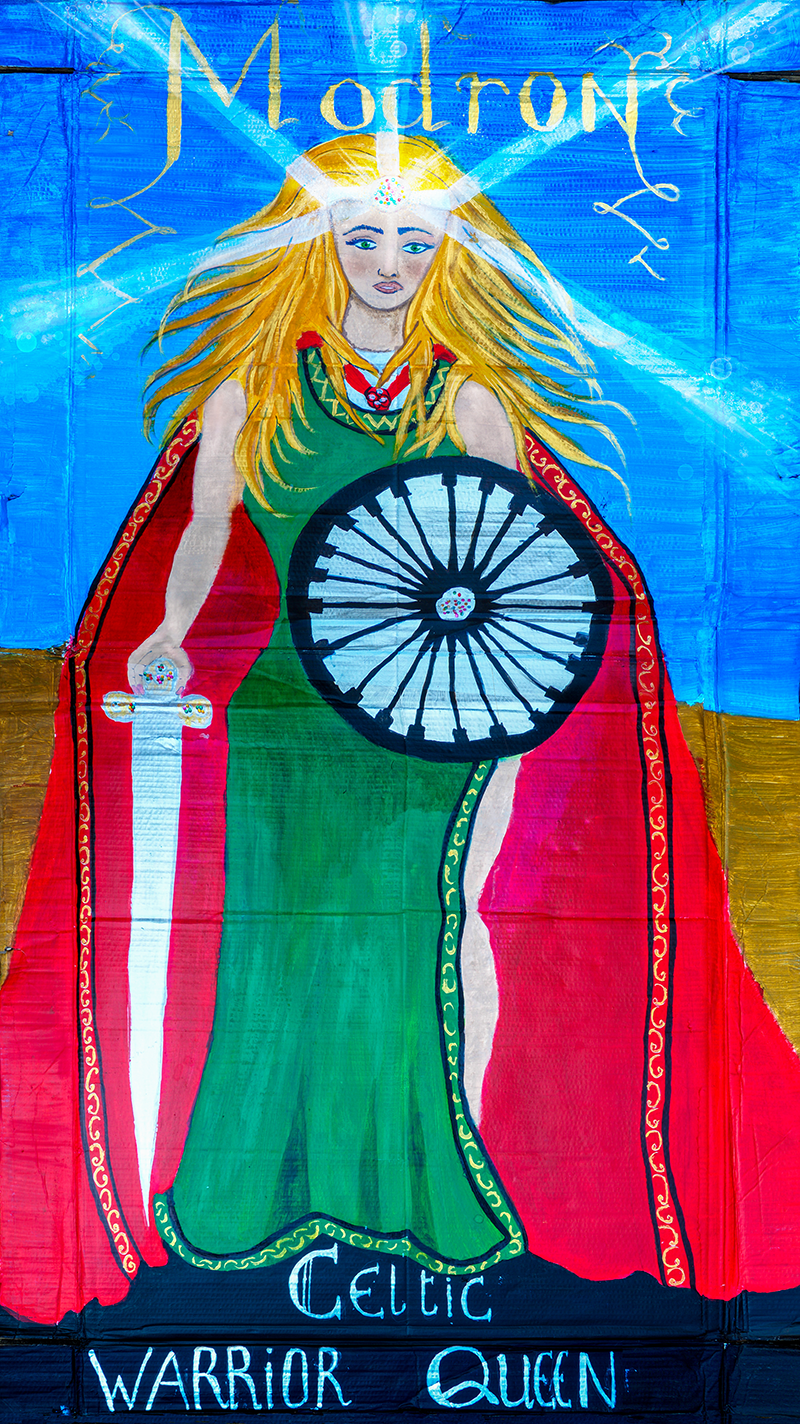Modron
By Barbara Candlish
Out of the mist of time
In these valleys you will find
A spirit in our blood and in our bones
It's written of the ancient days
Silures age old Celtic Tribe
In south east Wales they did abide
Fierce strong warriors bold were
undefeated
Held Roman forces in abeyance.
On and on they fought for freedom
each intruder to our land
Down through the decades
Life was harsh, life was grim
She's always there Modron Celtic warrior Queen
Her fighting spirit can be seen.
To fight injustice, right the wrong
In every miner's struggle she was there
Walking with
the Chaterist to Newport square.
Saving every penny to heal the sick
Nursing the injured in the pit
the NHS was born.
Women widowed far too young
Clung together to survive
They didn't ask when or how.
They shouted out we'll do it now
Her spirit is in our blood and in our bones
He wrote of the loss of our Valleys green
Now the beauty all around
us can be seen
Modron our Celtic Warrior Queen
View full size
About this work
Modron’s depiction in the painting is truly striking, with her flowing hair and cloak, her warrior’s sword and shield. The poem, meanwhile, associates her with the Silures; a Celtic tribe occupying what we now call Blaenau Gwent when the Romans arrived
two thousand years ago. Together the two pieces, painting and poem, depict her as a Boudicca figure representing strength, independence and indominable will. That shines through in the second and third verses of the poem, in which Modron’s spirit
echoes down the ages through the chartist movement, the creation of the NHS, and the suffering endured by women in the mining communities of the Gwent Valleys.
In the text below, the creator of both pieces Barbara Candlish talks about her inspirations. Whilst she focuses primarily on the painting, her words reveal a good deal about the poem as well. In particular, she draws connections between the legend
of Modron and a more recent myth from the south Wales valleys. The Welsh Mam is an idealised matriarch. She is the lynchpin holding the family together, hers is the strength that sees them through adversity. In Barbara’s poem and in her reflection
below as well, the theme of continuity through time is writ large. Whether a hundred years ago or two thousand, for Barbara the unacknowledged power of Blaenau Gwent’s women demands recognition.
The idea for this artwork evolved into what it has become – Modron mythical Welsh Celtic queen, a Welsh Superhero. This art is part of the O.U. project BG REACH. The ethos of BG REACH is to celebrate Blaenau Gwent, to reflect on the past and to look at
what there is to be proud of and to celebrate. My first idea was to draw and paint a woman that would be half modern and half in traditional Welsh dress, making the comparison of how Welsh women looked in the past and how they look now.
Then after attending a history workshop, that was given by an Open University historian, as part of BG REACH programme. I was amazed to learn about the Silures, a Welsh Celtic Tribe. The Silures occupied the south east corner of south Wales,
what is now Blaenau Gwent. They were a powerful and warlike tribe or tribal confederation and they were never defeated by the Romans.
I had never heard of them, but I know that their present-day descendants have their DNA and their spirit. There is that spirit in the valleys, and this gave me the idea of a Superhero – especially as I know children love a superhero. Keeping
with the idea of a woman, as the women of the valleys are strong, determined and nurturing, I thought about the ‘Welsh Mam’. The story of the valleys women, I do not think, is written about; their voice is not heard.
Here is a true story which encapsulates the spirit of the ‘Welsh Mam’. It is about my sister-in-law’s grandmother, probably 1920-30s. Mrs Margaret Ellen Davies of Trecenydd Caerphilly had nine surviving children and was three months pregnant,
carrying my sister in law’s father. Her husband was kicked by a horse underground; he was saving the horse from a runaway tram. They brought him home and he took three days to die. She was now a widow and was unable to pay the rent, so she got together
with her friend who was also a widow with children and they shared a house. Then the friend died and she continued to care for her children plus her own children. The friend’s children were taken from her, but she fought to get them back and she succeeded.
The day she got them back they had a party – a handful of dolly mixtures and some bread and jam. She continued to care for all the children until they were grown. She is our superhero, and her story would not have been an uncommon one amongst Valleys
women at that time. She is the Welsh Mam, and she is Modron too.

This page is part of the Blaenau Gwent REACH online exhibition.
Film and audio | Creative writing | Visual art
Digital stories | The history of Blaenau Gwent | About this project

Rate and Review
Rate this article
Review this article
Log into OpenLearn to leave reviews and join in the conversation.
Article reviews